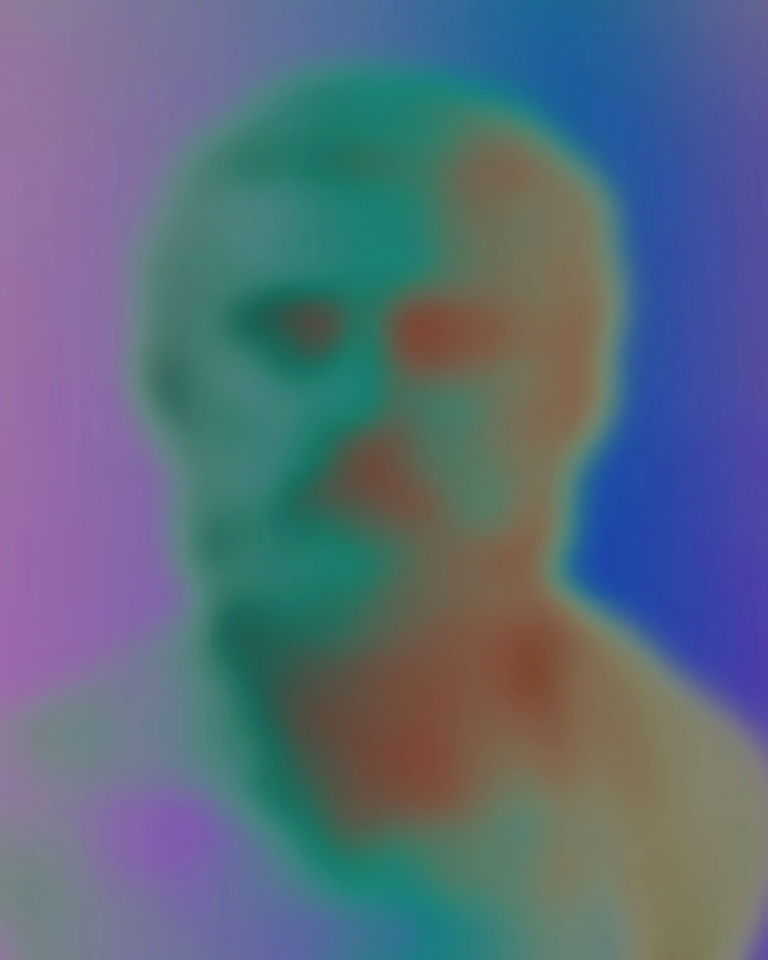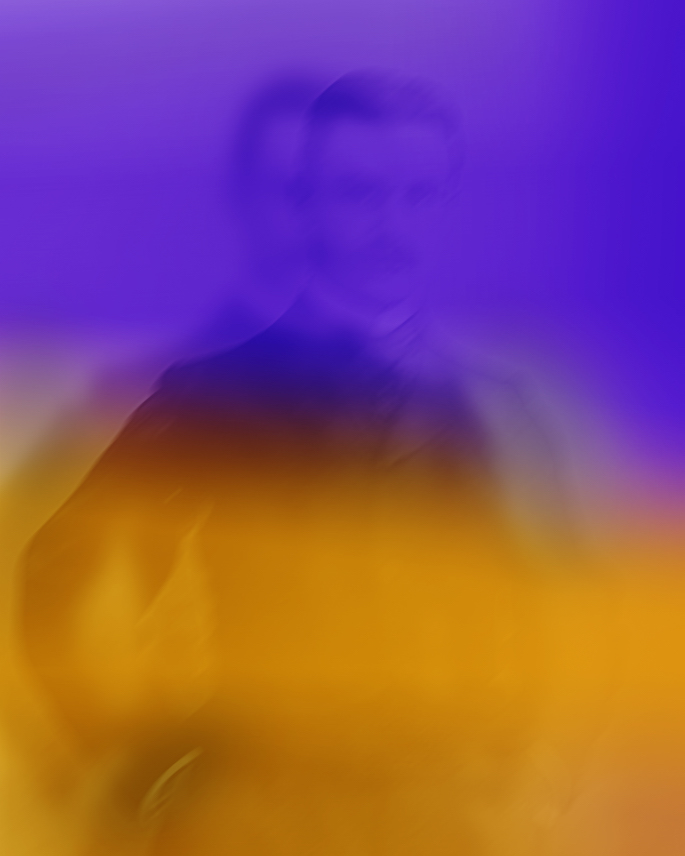Quarantine, a series that comprises roughly half of Bill Armstrong’s current two-part exhibition, Unspoken, contains no Ouija boards or images of spouting ectoplasm, though neither would feel out of place. That is because the New York photographer is engaged in something of a conjuring act: While in lockdown last year, he downloaded images of artists and thinkers who lived in perilous times analogous to our own and subjected them to digital manipulations that effectively thrust them into the present. These camera-less resurrections, coupled with facts and quotations (readable in an accompanying catalog) couldn’t be timelier. From Shakespeare, Sophocles, Frida Kahlo, Nelson Mandela, Egon Schiele, Thomas Mann, Virginia Woolf and others we learn of human predicaments every bit as bad as our own, if not worse, and from them we take heart.
Bill Armstrong | Portrait of Frida Kahlo, 2020 | Chromogenic prints | 24 x 20 inchesSophocles, staring out at us with blackened, hollowed-out eyes, his skull bathed in Warholian hues, declaims from Oedipus Rex: “…the God of Plague/Hath swooped upon our city emptying/The house of Cadmus, and the murky realm/Of Pluto is full fed with groans and tears.” Egon Schiele’s visage, half-pink, half green and diagonally blurred, as if captured in driving rain, is accompanied by a letter written to his mother telling of his wife’s imminent death from the Spanish flu. (Both, along with their unborn child, died within three days of each other, in October 1918). A sumptuous portrait of Thomas Mann shows the author in a haze of violet and gold, his head a double image, as if photographed with a long exposure. The accompanying quote comes from Death in Venice: “Solitude gives birth to the original in us, to beauty unfamiliar and perilous – to poetry. But also, it gives birth to the opposite: the perverse, the illicit, the absurd.” The San Francisco sculptor Ruth Asawa, suffused in a fuchsia-tinged gold-green gradient, strikes a defiant, hand-on-hip glamor pose. Of her imprisonment in a Japanese internment camp during World War II she said: “Sometimes good comes through adversity. I would not be who I am today had it not been for the internment, and I like who I am.”

Bill Armstrong | Portrait of Sophocles, 2020 | Chromogenic print | 24 x 20 inchesArmstrong has long probed issues of mortality, transience and immateriality. After seeing Uta Barth’s retrospective at MOMA in 1994, he ran experiments of his own beginning in 1997 with the first of what became an ongoing series called Infinity — named for his practice of using the infinity setting on his camera to photograph painted collages made from found images shot at close range to produce compositions in which seams dissolved and colors ran together. The method has proven both potent and highly malleable: The artist has used it for at least 11 distinct bodies of work within the series, all of which share a common goal of “gradually building what I think of as a parallel universe that is meant to represent a dematerialized, ephemeral version of culture and history as it explores different religions, periods of art history and philosophies.” As such, his oeuvre resonates broadly, with affinities to artists ranging from Edvard Munch and Gerhardt Richter to David Maisel and Jim Campbell to name just a few.
Quarantine, an all-digital series, calls on two related photographic traditions: the blur and spirit photography, and, to a somewhat lesser degree, color field painting. While the colors – monochrome, adjacent, complementary– into which Armstrong submerges his subjects can sometimes feel a bit overheated, they never detract from the overall impact. In certain portraits, like that of Mahatma Gandhi and the abolitionist writer Harriet Jacobs, they actually heighten it by calling to mind the color shifts that occur when you accidentally open the back of a film camera. To look, then, is to experience something akin to a séance, with all the catharsis such exercises provided during other times of crisis, those being the years after the Civil War and World War I, when Americans, grieving staggering losses of life, sought solace in spiritualists, who, it should be noted, also did a thriving business in Europe. Never mind that many of those involved were hucksters. What mattered most was being able to commune with the dead. o be clear, it’s unlikely that anyone will walk into this exhibition thinking they can do that; the epiphany on offer is the realization that humanity has survived pandemics, wars and natural disasters.
Unspoken, the other half of the show (which doubles as the title for both segments) consists of earlier (2016) analog collages that Armstrong painted and rephotographed. They, too, lean heavily on the blur and show figures in noirish settings painted in hot colors. However, it’s the Quarantine images, with their explicit references to literary figures and historic events, that are the exhibition’s star attractions. Like Churchill’s exhortations to Londoners during the Blitz, these pictures, despite the misery they reference, give us hope at the precise time we need it most.
Bill Armstrong | Portrait of Thomas Mann, 2020 | Chromogenic print | 24 x 20 inches


